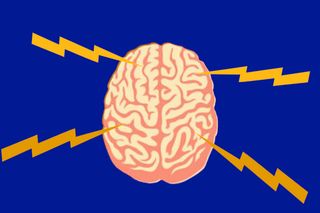
Can Zapping People’s Brains Prevent Them From Committing Violent Crimes?
A study suggests it’s possible — but the better question is whether we should.

Last week, scientists at the University of Pennsylvania shared some curious findings: “Increasing activity in the prefrontal cortex can reduce intentions to commit aggression and enhance perceptions of moral judgment.”
In the study, half of the participants received electrical stimulation to the prefrontal cortex (the brain region responsible for higher reasoning, moral judgment and self-restraint) and half did not. (No one in either group knew whether they had received stimulation.) The next day, they all read brief stories of violence — a bar fight, or a rape. Finally, they were asked: “Would you do that?”
The stimulated group was 47% less likely to say they might act similarly to the aggressor in the fictional physical assault, and 70% less likely to say they might act similarly to the aggressor in the fictional sexual assault. They also rated the violence in the stories more morally wrong than the control group.
What makes this study particularly exciting is the seeming chance not just to prevent recurrent violence, but prevent violence altogether. The UPenn scientists focused on stimulating a specific spot of the prefrontal cortex that brain scan research has shown to be typically smaller and less active in people who are antisocial, aggressive, or both.
Altering biology in order to prevent violence has been the premise of many a science fiction film. It’s had its place in real life, also. In mid-20th century America, forcible lobotomies — procedures that severed connected parts of the brain, often the frontal lobe from the rest of the brain — were a legitimate treatment for violent people (often suffering from untreated mental illness). And chemical castration is still a viable sentence for sex offenders, usually child rapists, in many countries.
There is a difference, of course, between stimulating a cognitive ability associated with good behavior, and cutting off functions used for bad; one is preventative, the other is retributive. Improved executive function — which includes impulse control, self-monitoring and emotional management — has benefits far beyond making someone less likely to commit a crime; it also makes people more likely to achieve at school and in life. India, in the midst of a regressive trend in its criminal justice laws, would do well to take note.
While such a procedure may seem more humane, it’s not without scope for abuse. “Would governments be tempted to extend its use beyond violence, such as ‘to induce passivity in politically unruly groups?'” asks Dr. Paul Appelbaum, director of the Division of Law, Ethics, and Psychiatry at Columbia University’s Vagelos College of Physicians and Surgeons, in a report by STAT News.
It will be a long time yet before we can know the answer. The study has been criticized for several flaws: The stimulated group included a disproportionately high number of women, who might find it more difficult to put themselves in the shoes of a rapist of women (as in the story they read). And neither group included people with a history of psychiatric or neurological disease or damage, which can make people more prone to violent tendencies.
These flaws in test group composition, and possibly in self-reporting, are evident in the second part of the study, when participants were actually given the chance to simulate violence. “In the only assessment of actual behavior, the participants got to stick pins into a computer image of a doll representing a close friend, a common lab test of violent tendencies. Those whose prefrontal cortex was stimulated stuck in slightly more pins than the control group,” reports STAT News.
The scientists say their next step is to see if longer or repeated electrical stimulation of the prefrontal cortex changes outcomes in violent intention. Until then — and maybe even after — biological prevention of crime may be best left to the movies.
Liesl Goecker is The Swaddle's managing editor.
Related


Babies Put Everything in Their Mouths. Here’s Why.
